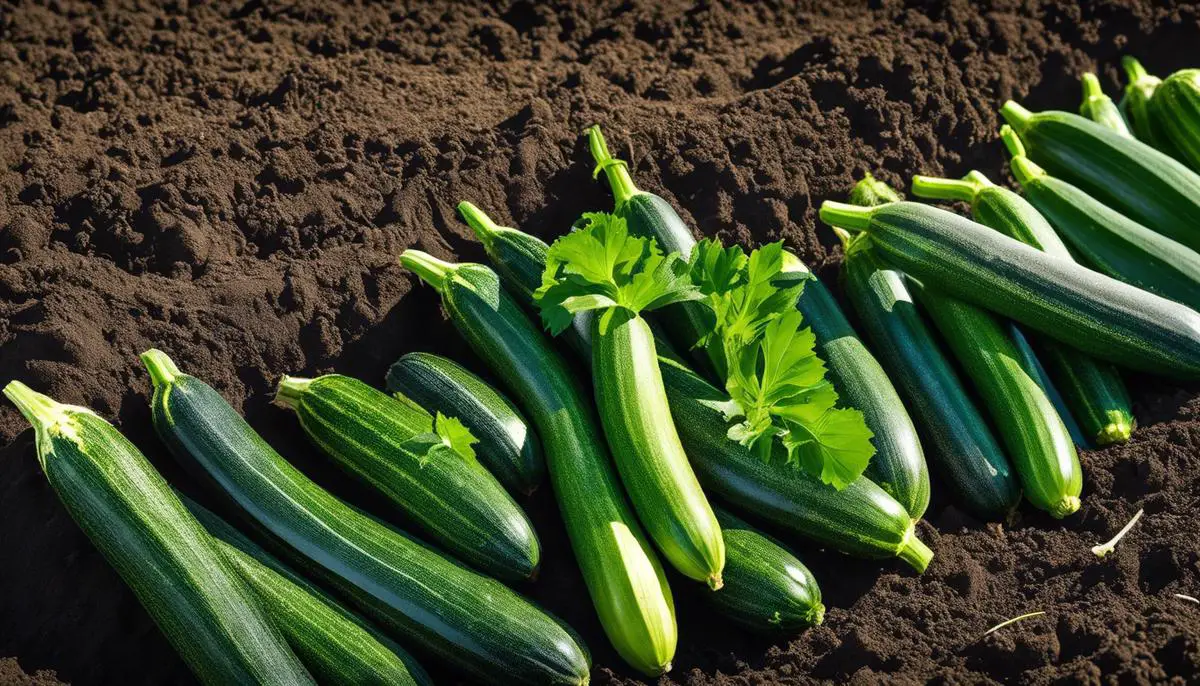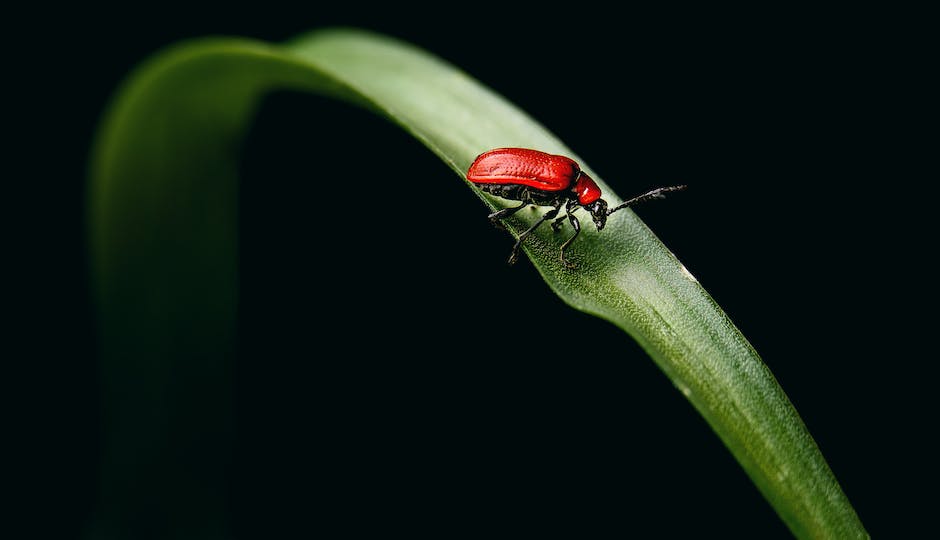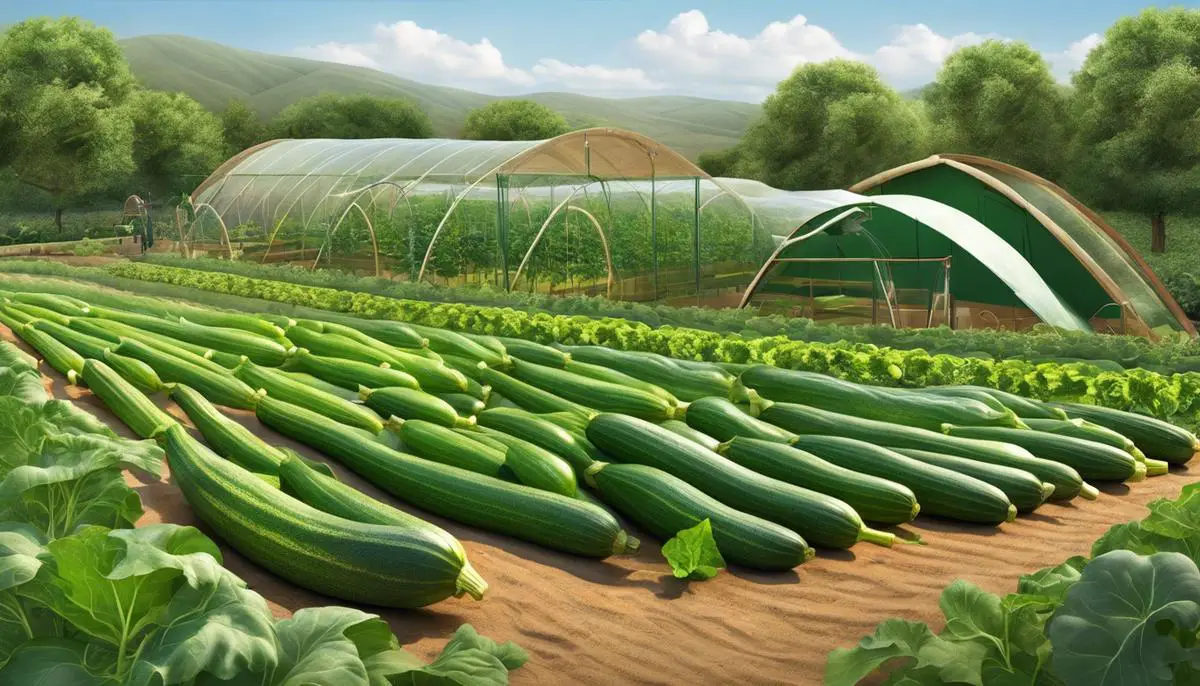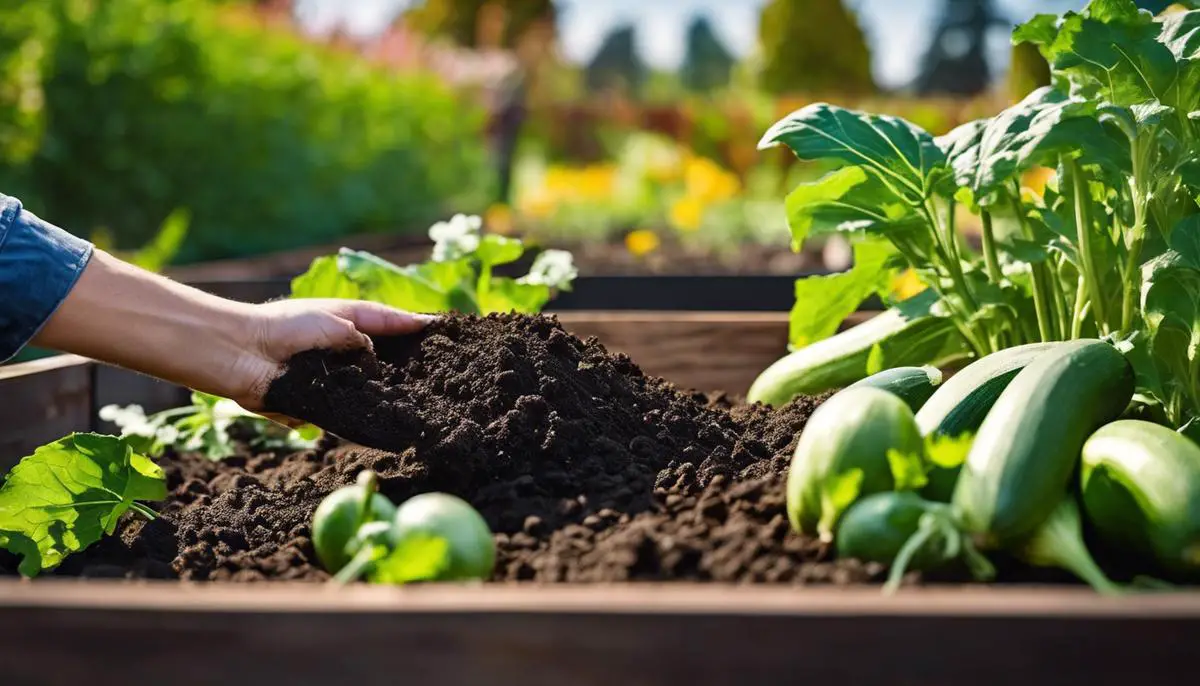As we embark on a deep dive into the world of organic zucchini cultivation, it is crucial to recognize the harmony between nature’s intrinsic processes and our agricultural practices. Cultivating this delectable squash organically necessitates a comprehensive understanding of everything from the lifegiving soil under our feet to the vital seeds that promise future bounty. With health and sustainability at the forefront, this essay illuminates the essential practices and considerations needed to nurture zucchini from seed to harvest without compromising the delicate balance of our ecosystem.
Soil Composition and Preparation
The Paramount Importance of Soil Health in Organic Zucchini Cultivation
Ensuring soil health is the cornerstone of successful organic zucchini cultivation. In the cultivation of zucchini (Cucurbita pepo), a species highly regarded by botanists and horticulturists for its nutritional value and culinary versatility, the preservation and enhancement of soil integrity is not merely beneficial but essential.
Reader Poll: What online courses would interest you?
Soil health is a comprehensive term that includes a multitude of physical, chemical, and biological properties. This virtual symposium on soil will elucidate how each attribute contributes profoundly to organic zucchini agriculture. In the discourse on physical soil health, we must consider texture and structure—keys to water retention and root penetration. Zucchini, with its voracious appetite for moisture and nutrients, depends upon a well-aerated loam that enables its roots to traverse the soil profile unrestrictedly.
Chemically, soil health directly influences the nutritional content of zucchini. By eschewing synthetic fertilizers, organic farmers rely on a soil rich in organic matter to supply the necessary nutrients, such as nitrogen, phosphorus, and potassium. Furthermore, soil pH holds considerable influence, with a slightly acidic to neutral pH typically being most conducive to zucchini growth. The balance of these nutrients and pH level affects not only plant health but also resistance to pests and diseases.
On a biological level, the teeming life within the soil – from bacteria and fungi to earthworms and arthropods – plays a vital role. This biotic community decomposes organic matter, fixates nitrogen, and converts nutrients into forms accessible to the zucchini plants. The symbiotic relationships formed between zucchini roots and mycorrhizal fungi are particularly remarkable, greatly expanding the root’s nutrient absorption capabilities.
Subscribe to our newsletter!
Alleys of research have revealed that practices like compost application, cover cropping, and reduced tillage profoundly benefit soil health. These methods increase organic matter, foster biological activity, and enhance soil structure, each factor contributing to a virtuous cycle of fertility that supports organic zucchini plants’ productivity and robustness.
In lieu of a summary, let this final point resonate: A soil’s health is not merely an arbitrary measure in organic farming; it is the bedrock on which the edifice of sustainable agriculture is built. As the foundation for bountiful and nutritious organic zucchini, the vitality of the soil cannot be overstated. Thus, attention to soil health is not simply a task for organic farmers—it is a fundamental doctrine that shapes the essence of their vocation.
“The Paramount Importance of Soil Health in Organic Zucchini Cultivation” by Unknown

Seed Selection and Planting Techniques
Continuing from the indispensable foundation of soil health, the selection of appropriate organic seed varieties for zucchini (Cucurbita pepo) is paramount. Heirloom and open-pollinated varieties tend to be well-suited for organic systems due to their genetic diversity and resilience, often showing greater tolerance to local pests, diseases, and environmental stressors. Varieties such as ‘Black Beauty’, ‘Cocozelle’, and ‘Costata Romanesco’ have proven optimal for organic cultivation, each offering distinctive traits, such as ‘Black Beauty’s’ rapid growth and rich flavor, ‘Cocozelle’s’ striped fruits and firm texture, and ‘Costata Romanesco’s’ exceptional taste and ribbed appearance.
Equally important to variety selection is the implementation of planting methods that enhance the sustainability and yield of the crop. Direct seeding and transplanting are the two primary methods employed. Direct seeding, sowing seeds directly into well-prepared soil beds, is cost-effective and less labor-intensive. It requires careful timing to ensure soil temperatures have adequately warmed to a range of 70-95 degrees Fahrenheit for optimal germination. Additionally, seeds should be spaced approximately 36 inches apart in rows to allow for air circulation and ease of management.
Transplanting, the process of starting seeds indoors and transplanting the young plants to the field, allows for an extended growing season and can provide a head start against weeds. Transplants require a well-regulated environment for 4-6 weeks before being moved to the field, and should be hardened off to adapt to outdoor conditions to avoid transplant shock.
Regardless of the method, maintaining adequate soil moisture is critical for both germination and establishment of young plants. Organic mulches such as straw can aid in preserving soil moisture, regulating soil temperature, and suppressing weed growth. The utilization of organic mulch not only supports the ongoing dedication to soil health but also fosters an environment conducive to the productivity and vigor of organic zucchini plants.
Through the judicious selection of resilient seed varieties and the adoption of thoughtful planting methods, the full potential of zucchini plants in an organic system can be realized. These practices, underpinned by thorough understanding and passion for sustainable agriculture, are instrumental in producing bountiful organic zucchinis while nurturing the intricate web of soil health.

Pest Management in Organic Zucchini Production
One of the paramount strategies for organic pest control in zucchini farming is the implementation of integrated pest management (IPM).
IPM is a system that combines biological, cultural, physical, and chemical tools in a way that minimizes economic, health, and environmental risks.
Biological control is the utilization of natural predators and parasites to keep pest populations in check. In the context of zucchini production, this might include introducing or sustaining populations of beneficial insects such as lady beetles and lacewings, which prey on aphids, or predatory mites that attack spider mites. Additionally, planting nectar-rich flowers can attract these beneficial organisms, thereby enhancing the ecological stability of the zucchini crop.
Cultural control methods involve altering the farming environment to reduce the incidence of pests. Crop rotation is vital, as it hinders the build-up of zucchini-specific pests in the soil by switching to different crops that are not suitable hosts. Interplanting zucchini with other crops can also deter pests due to the increased diversity, which makes it difficult for pests to find their preferred host plants.
Physical controls, such as the use of row covers, can prevent pests such as squash vine borers and cucumber beetles from reaching the zucchini plants. Row covers should be removed during flowering, to allow for pollination by beneficial insects or managed pollinators. Handpicking larger pests like squash bugs is another direct, albeit labor-intensive, physical control measure that can be quite effective in smaller scale operations.
Additionally, organic farmers may employ certain permitted organic pesticides, derived from natural sources rather than synthetic chemicals. For example, neem oil and insecticidal soaps can target soft-bodied pests without leaving harmful residues. However, these treatments should be used judiciously and as a last resort, as overuse can disrupt the balance of beneficial organisms.
A fundamental aspect of pest control is monitoring. Regular scouting of zucchini plants for signs of pests and damage ensures that early actions can be taken before infestations become problematic. This proactive approach includes identifying specific pests and understanding their life cycles to implement control measures at the most effective time.
In conclusion, organic pest control in zucchini farming is a multifaceted approach that requires a deep understanding of ecosystem dynamics. By integrating biological, cultural, physical, and selective organic pesticide methods within the scope of IPM, farmers can maintain zucchini plant health and yield while adhering to the principles of organic farming. Effective pest management in organic zucchini cultivation is not a one-size-fits-all solution but a tailored system that reflects the complexities of the natural world.

Irrigation and Water Management
Water Management in Organic Zucchini Gardening: A Key to Sustainability
Efficient water management is critical in organic zucchini gardens, not only as a means to ensure the growth and development of the plants but also to uphold the principles of sustainability inherent in organic farming. Water is a finite resource, and its judicious use is especially important in areas where scarcity can limit agricultural productivity.
Organic zucchini plants require a consistent and appropriate quantity of water from germination to harvest. Water stress, whether from overwatering or underwatering, can lead to poor fruit development and increased susceptibility to pests and diseases. The facilitation of optimal water availability throughout the lifecycle of the zucchini is therefore a paramount concern.
One of the primary methods for sustainable water management is the timing and delivery of irrigation. Drip irrigation, for instance, can be particularly effective in delivering water directly to the root zone of plants, minimizing evaporation and runoff. This localized application helps ensure that plants receive the necessary hydration without wasting water. Furthermore, drip irrigation systems can be automated and regulated to respond to climatic conditions, reduce labor, and optimize water use efficiency.
Complementing drip irrigation, the use of organic mulches, previously mentioned for their role in soil moisture conservation, can further contribute to water efficiency. Mulches reduce water evaporation from the soil surface, hence extending the intervals between water applications and mitigating the requirement for supplemental watering. This decrease in water usage not only preserves the precious resource but also saves energy and reduces the carbon footprint associated with water extraction and distribution.
Another significant aspect of water management is the recognition and integration of water harvesting techniques. Capturing rainwater through various systems can provide a supplemental source of water for the garden. Rainwater, generally being soft and devoid of chlorine and other chemicals found in municipal water supplies, can be an excellent option for organic gardens, contributing to maintaining soil health and ecological balance.
The selection of zucchini seed varietals adapted for local climatic conditions can also have a profound impact on water use. Varieties that are resilient to local weather patterns and soil conditions will generally require less intervention and less water. Supporting these resilient varieties with soils rich in organic matter ensures a higher water-holding capacity of the soil, reducing the need for frequent watering and bolstering the plant’s tolerance to both dry and wet conditions.
Efficient water management in organic zucchini gardens fosters resilient ecosystems by reducing the strain on natural water sources, limiting soil erosion, and promoting the long-term viability of the soil. Its holistic approach contributes significantly to the overarching goals of enhanced yield, quality of produce, ecological balance, and the preservation of the environment for future generations.
In adopting effective water management practices, organic zucchini gardens can thrive and serve as models of sustainability and stewardship in the broader agricultural landscape. These practices are inextricably intertwined with the health of the organic zucchini plant and the ecosystem at large, underlining the interconnected nature of all elements within organic farming systems.

Harvesting and Post-Harvest Handling
Upon the proper cultivation of organic zucchini, one’s attention must pivot to the judicious procedures for harvesting and handling these verdant fruits to ensure their quality. Maintaining the integrity of organic zucchini from garden to table demands a confluence of timeliness, delicate handling, and post-harvest care.
The timing of harvest is critical. Zucchini should be harvested when they reach a size that is ideal for consumption, usually when they are approximately 6 to 8 inches in length. This not only guarantees optimal flavor and texture, but also encourages the plant to continue producing more fruit. Harvesting should take place during the cooler parts of the day to lessen stress on both the plant and produce.
Handling techniques are pivotal to prevent bruising and other damage that could compromise the zucchini’s marketability and shelf life. A soft touch is essential; zucchini should be cut rather than pulled from the plant, using sharp and clean shears or a knife to lessen the damage to the vine. In addition, it is advisable to leave a small portion of the stem intact to reduce the potential for rot.
Post-harvest, the objective is to limit the zucchini’s exposure to the elements, and to carefully regulate its environment. Promptly cooling the harvested fruits to around 50°F prevents the acceleration of decay. Nonetheless, avoid excessively cold temperatures that could inflict cold injury and diminish the zucchini’s quality.
The storage environment should be humid, yet not so moist as to encourage the growth of molds. Typically, a humidity level of 95% is ideal for preserving the zucchini’s firmness and preventing dehydration. Furthermore, gentle stacking or placement in single layers can prevent pressure spots and bruising during storage and transport.
Rapid and efficient transportation to the market or storage facility is also essential to avert quality deterioration. Organic zucchini are quite perishable; thus, any delay can diminish their shelf life and appeal.
Handling and packaging materials need to be chosen with care. Employing containers that facilitate ventilation will help to dissipate heat and maintain an even temperature around the zucchini. Packaging materials should be free from contamination to uphold the standards of organic produce.
Adhering to these best practices in harvesting and handling not only safeguards the quality of the organic zucchini but also fortifies the principles of organic agriculture that are foundationally committed to the health of the environment and the well-being of consumers. Through the lens of sustainable practices, the trajectory from seedling to table should be handled with both scientific precision and an unwavering commitment to the natural integrity of the produce. It is within these meticulous steps that organic zucchini retains its utmost quality, flavor, and nutritional value.

The successful cultivation of organic zucchini is as rewarding as it is challenging, demanding not only diligence but also a profound respect for the natural world. By integrating the practices of careful soil preparation, judicious seed selection, strategic pest management, thoughtful water conservation, and meticulous post-harvest care, growers can achieve a bountiful harvest that is as good for the earth as it is for our bodies. Embracing these organic principles elevates the simple act of vegetable gardening into a poignant statement of environmental stewardship and a testament to the enduring bond between humans and the land they cultivate.

